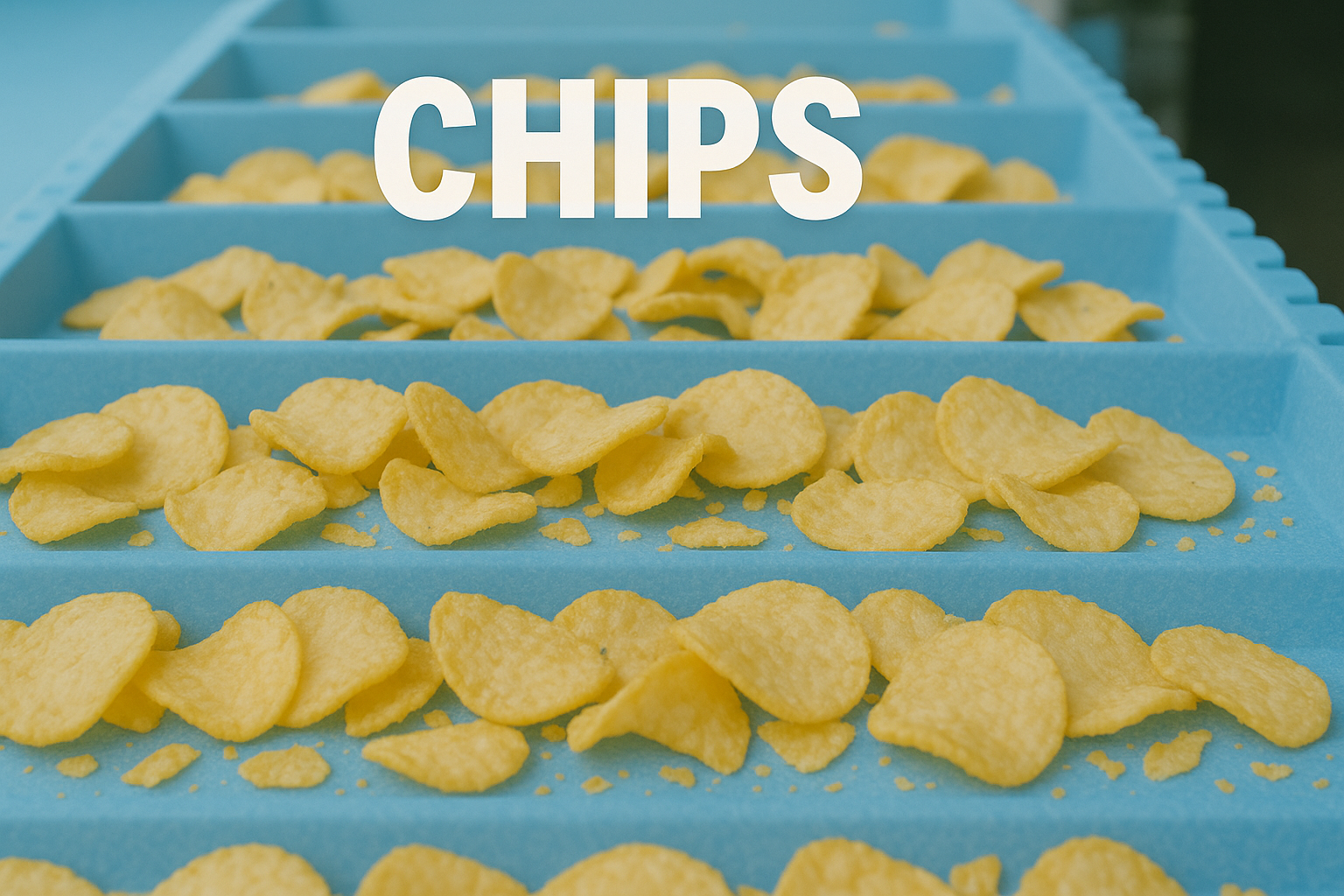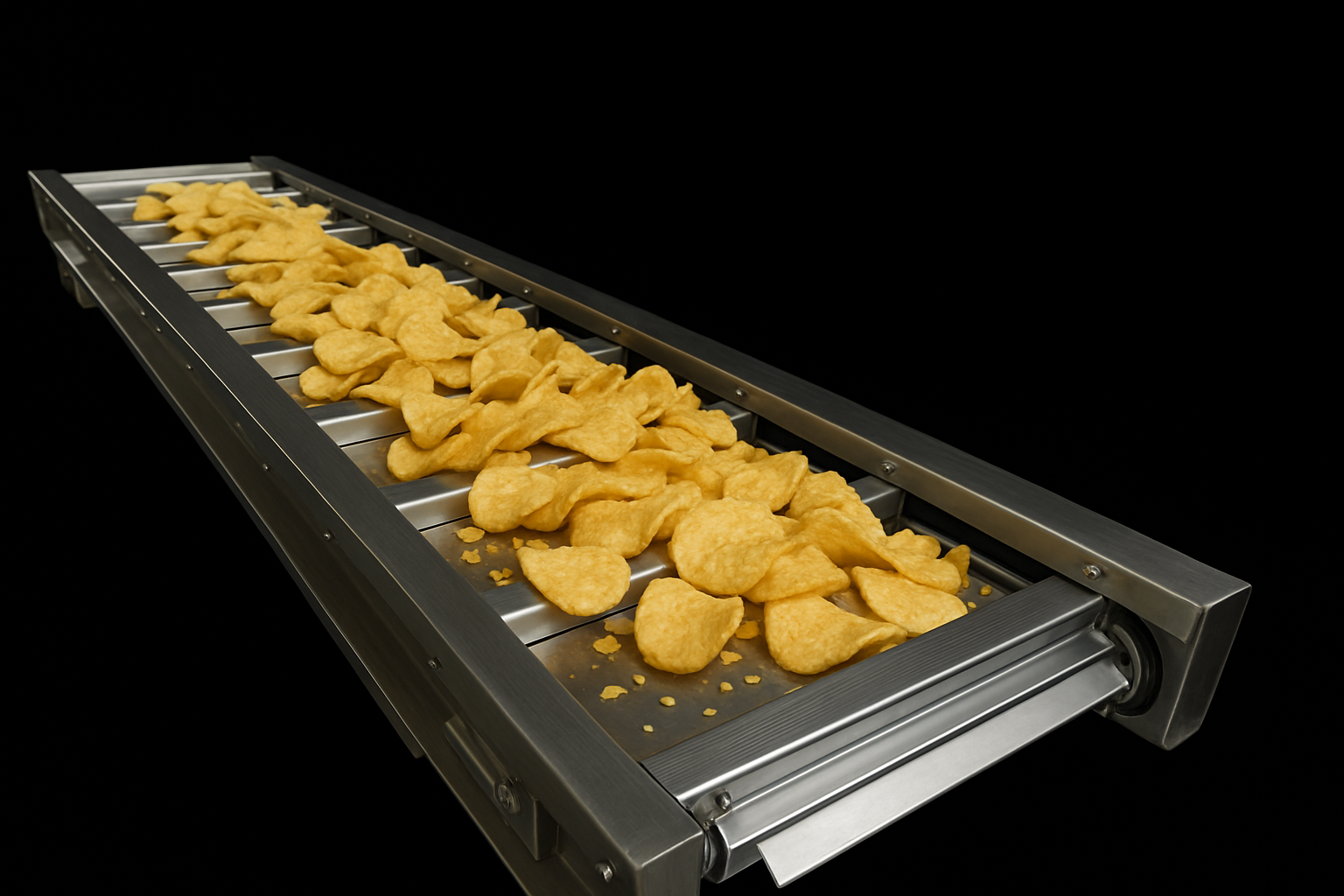Potato chips are one of the world’s favorite snacks, widely enjoyed for their crisp texture and convenient packaging. The right conveyor materials directly impact the quality, efficiency, and cost-effectiveness of your chips packaging process. As you select a chips packaging machine or an automatic potato chips packing machine, choosing suitable conveyor materials is critical.
In this blog, we’ll cover:
-
Overview: Conveyor Material Choices in Chips Packaging
-
PU Conveyors: Benefits and Applications
-
Stainless Steel Conveyors: Key Roles and Advantages
-
Optimal Solution: Combining PU with Stainless Steel
-
Choosing Conveyor Materials Based on Chip Types & Factory Conditions
-
Real-World Examples and Industry Insights
-
Boosting Efficiency and ROI in Potato Chips Packaging
1. Overview: Conveyor Material Choices in Chips Packaging
When selecting conveyors for potato chips, two primary materials dominate:
-
PU (Polyurethane): Ideal for direct contact with potato chips, particularly in post-cooling packaging stages.

-
Stainless Steel: Preferred for conveyor frameworks and high-temperature post-frying transport due to its durability and sanitary qualities.
Understanding their respective roles helps ensure reliable and cost-efficient packaging for chips.
2. PU Conveyors: Benefits and Applications
Minimizing Breakage
-
High elasticity (Shore hardness 80A-95A), significantly reducing chip breakage during transport (50%+ improvement).
-
Low friction coefficient (0.3-0.5), minimizing surface abrasion.
Food Safety Compliance
-
FDA and EU 10/2011 compliant, guaranteeing food-safe transport with no contamination.
-
Smooth surface compatible with CIP (Clean-In-Place), ensuring efficient cleaning and hygiene.
Functional Enhancements
-
Optional anti-static properties prevent chip debris from adhering to surfaces.
-
Antimicrobial coatings available to prevent bacterial growth.
Ideal Applications
-
Conveyors directly contacting chips during sorting, weighing, and packaging.
-
High humidity environments and washdown zones.
-
Lightweight, high-speed conveying (up to 60m/min) for thin, fragile potato chips.
Limitations
-
Maximum operating temperature typically around 80°C, not suitable for high-temperature sterilization.
-
Limited strength compared to steel; extra structural support required for heavier chip loads (>150g packages).
3. Stainless Steel Conveyors: Key Roles and Advantages
Core Uses
Primarily employed in structural and framework components rather than direct chip-contact points.

Sanitary & Durable
-
304/316 stainless steel resists corrosion, tolerates aggressive sanitation methods (high-temperature washes >100°C).
-
Ensures hygiene compliance for stringent GMP environments.
High Load Capacity
-
Supports heavy machinery such as multihead weighers and packaging systems.
-
Long-term durability, providing 10–15 years of dependable service versus PU conveyor belts’ 3–5 years.
Recommended Applications
-
Structural frames, protective guards, and water collection trays.
-
Harsh production environments with frequent cleaning and moisture exposure.
-
Heavy-duty conveyors moving packed cases or boxes.
4. Optimal Solution: Combining PU with Stainless Steel
The industry-standard configuration for a potato chips packing machine combines PU belts with stainless steel frameworks, balancing functionality and cost-effectiveness:
| Component | Material | Key Design Features |
|---|---|---|
| Conveyor Belt | Food-grade PU | 2–5mm thick with diamond pattern for anti-slip |
| Frame | 304 Stainless Steel | Quick-release structure, smooth polished welds (Ra≤0.8μm) |
| Drive Roller | Stainless Steel core + PU coating | Slip-resistant, quiet operation (<65 dB) |
| Legs | Adjustable stainless steel feet | Shock-absorbent, suitable for uneven surfaces |
5. Choosing Conveyor Materials Based on Chip Types & Factory Conditions
Based on Potato Chip Type:
-
Thick/Ripple-cut Chips:
Use highly elastic PU (Shore hardness around 80A) combined with wider belts (≥400mm) to minimize stacking pressure and prevent damage. -
Thin, Fragile Chips:
Anti-static PU conveyors with stainless steel vacuum trays minimize chip dust and breakage.
Based on Factory Environment:
-
Dry Environment:
PU conveyor belts offer superior economy. -
High-Humidity or Frequent Cleaning:
Stainless steel frameworks paired with PU belts provide durability, rust resistance, and ease of sanitation.
Maintenance Cost Comparison:
| Maintenance Aspect | PU Conveyor Belt | Stainless Steel Structure |
|---|---|---|
| Replacement Cycle | 3–5 years | Rarely replaced, extremely durable |
| Cleaning Ease | Easy (Residue-free) | Regular anti-corrosion treatments recommended |
| Replacement Cost | Approx. $75–$300/meter | Typically not applicable |
6. Real-World Examples and Industry Insights
-
Lay’s Potato Chip Production Line (Premium Model)
-
Conveyor: German Forbo Siegling FDA-compliant PU belt
-
Framework: 316 stainless steel, withstands aggressive cleaning
-
Performance: 100 packs/minute, chip breakage <0.3%
-
-
Mid-Scale Chip Manufacturer (Economical Setup)
-
Conveyor: Domestic FDA-compliant PU belt (e.g., Wuxi Belt)
-
Framework: 304 stainless steel with sandblasted surface
-
Cost reduction: 30%-50%, maintaining acceptable hygiene standards
-
7. Boosting Efficiency and ROI in Potato Chips Packaging
Selecting the appropriate conveyor materials significantly enhances overall packaging efficiency and return on investment.
Production Speed & Efficiency
-
Combining multihead weighers (10 or 14 heads) with VFFS packaging machines can achieve speeds of 30–90 packs per minute, increasing productivity by 300% compared to manual processes.
Flexible Production
-
Touchscreen interfaces facilitate rapid package-size adjustments within minutes, accommodating varying market demands and diverse product orders.
Product Freshness & Shelf Life
-
Nitrogen-flushing (Modified Atmosphere Packaging) and high-barrier films keep potato chips fresh for months, providing premium packaging for chips.
Cost-Effectiveness & Sustainability
-
Energy-saving servo motors reduce energy consumption by up to 30%.
-
Intelligent film thickness adjustments minimize plastic usage, meeting environmental standards and consumer expectations.
Intelligent Safety & Compliance
-
IoT-enabled systems and AI-based quality control reduce downtime and maintain high safety standards (CE-certified safety systems).
-
Automated visual inspection drastically reduces product defects and breakage, improving consumer satisfaction.
Conclusion
In potato chip production lines, the combination of PU conveyor belts (for product contact) and stainless steel frameworks (for structural integrity) offers the optimal balance of quality, efficiency, hygiene, and cost-effectiveness. Understanding conveyor material choices ensures you select a suitable chips packaging machine or automatic potato chips packing machine that meets your production and quality objectives.
Looking to optimize your chip packaging operations?
Contact us today for expert advice, a personalized consultation, or to arrange a demonstration.


Pingback: sildenafil 100mg cost